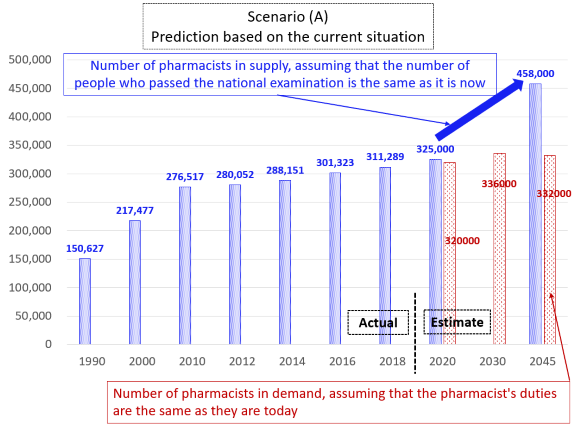Column Finance and the Social Security System 2021.07.19
【Aging, safety net and fiscal crisis in Japan】No.318:The supply of pharmacists exceeds the demand in 2020
In this column series, Yukihiro Matsuyama, Research Director at CIGS introduces the latest information about aging, safety net and fiscal crisis in Japan with data of international comparison
The pharmacist system study committee, which was established by the Ministry of Health, Labour and Welfare, released a report on June 16, 2021 that estimated the future supply and demand of pharmacists. The ministry surveys the number of pharmacists every two years. As shown in Figure 1, this figure more than doubled from 150,627 in 1990 to 311,289 in 2018. This exponential growth can be attributed to the establishment of new pharmacy departments at universities. The number of pharmacy departments has increased from 46 in 2002 to 77 in 2020. As a result, their enrollment capacity also increased from 8,200 to 13,050 in the same period.
As of 2020, there were 325,000 pharmacists, which exceeded the committee’s estimated demand of 320,000. Being a pharmacist is a popular profession because there are still many areas where pharmacists are in short supply, and it is relatively easy to get a pharmacist’s job. In the national pharmacist examination that took place in February 2021, 14,031 attempted the examination and 9,634 passed. The committee predicts that the number of pharmacists will reach 458,000 by 2045, assuming that the number of new pharmacists per year will not decrease. In contrast, the demand for pharmacists in 2045 is estimated to be only 332,000, assuming that the duties of pharmacists remain the same.
However, the committee also presented another scenario (Figure 2). Assuming that the number of people taking the national pharmacist examination decreases as the population declines, the number of pharmacists in 2045 is projected to decrease from 458,000 to 432,000. In contrast, assuming that the role of pharmacists in medical care expands, the number of pharmacists needed by 2045 will increase from 332,000 to 408,000. Even so, the supply of pharmacists will greatly exceed the demand. This suggests that a rigorous selection of pharmacy departments will begin.
Figure 1 Pharmacist in supply and demand forecast(Scenario A)

Source: Ministry of Health, Labour and Welfare
Figure 2 Pharmacist in supply and demand forecast(Scenario B)

Source: Ministry of Health, Labour and Welfare
